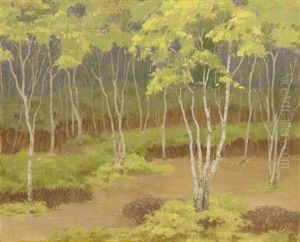Theodore Scott Dabo Paintings
Theodore Scott Dabo was an artist known for his ethereal landscape paintings, primarily of nocturnal seascapes. Born in 1874 in France, Dabo's family moved to the United States during his childhood, settling in Detroit, Michigan. There, Dabo's artistic talents were nurtured, and he began his formal education in art. His upbringing in the late 19th century placed him in a period of significant transition in the art world, as traditional academic styles began to give way to more experimental and expressive movements.
Dabo's artistic career was influenced by his older brother, Leon Dabo, who was also a successful painter, known for his tonalist landscapes. Theodore's work, similar in style to his brother's, often depicted serene and softly lit seascapes and landscapes that exuded a sense of calm and contemplation. These works often featured a limited color palette, focusing on the subtle gradations of light and shadow to create their tranquil atmosphere.
Dabo exhibited his work in various venues. His paintings were shown alongside those of well-known artists of the time and were well received by critics and the public alike. He became part of the artistic circles that included influential artists and writers, and his work contributed to the broader conversations about the direction of American art in the early 20th century.
Despite his artistic talents, Theodore Scott Dabo did not achieve the same level of fame as his brother Leon. However, he remained dedicated to his work throughout his life and continued to produce evocative landscape paintings that reflected his personal vision and artistic sensibilities.
Theodore Scott Dabo died in 1928, leaving behind a body of work that, while perhaps not as widely recognized as that of some of his contemporaries, offers a glimpse into the transitionary period of American art. His paintings are a testament to the tonalist style that bridged the gap between the Hudson River School and the more modernist approaches that would dominate the 20th century.






